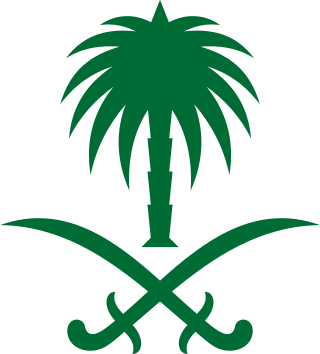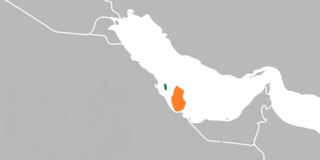Related Research Articles

The economy of Bahrain is heavily dependent upon oil and gas. The Bahraini Dinar is the second-highest-valued currency unit in the world. Since the late 20th century, Bahrain has heavily invested in the banking and tourism sectors. The country's capital, Manama is home to many large financial structures. Bahrain's finance industry is very successful. In 2008, Bahrain was named the world's fastest growing financial center by the City of London's Global Financial Centres Index. Bahrain's banking and financial services sector, particularly Islamic banking, have benefited from the regional boom driven by demand for oil. Petroleum is Bahrain's most exported product, accounting for 60% of export receipts, 70% of government revenues, and 11% of GDP. Aluminium is the second most exported product, followed by finance and construction materials.

Foreign workers or guest workers are people who work in a country other than one of which they are a citizen. Some foreign workers use a guest worker program in a country with more preferred job prospects than in their home country. Guest workers are often either sent or invited to work outside their home country or have acquired a job before leaving their home country, whereas migrant workers often leave their home country without a specific job in prospect.

The Gulf rupee was the official currency used in the British protectorates of the Arabian Peninsula that are around the Persian Gulf between 1959 and 1966. These areas today form the countries of Kuwait, Bahrain, Qatar, Oman, and the United Arab Emirates. It was issued by the Government of India and the Reserve Bank of India and was equivalent to the Indian rupee.

A migrant worker is a person who migrates within a home country or outside it to pursue work. Migrant workers usually do not have the intention to stay permanently in the country or region in which they work.

Saudization, officially the Saudi nationalization scheme and also known as Nitaqat, is a policy that is implemented in the Kingdom of Saudi Arabia by the Ministry of Labor and Social Development, which requires companies and enterprises to fill their workforce with Saudi nationals up to certain levels.

Bahrain's record on human rights has been described by Human Rights Watch as "dismal", and having "deteriorated sharply in the latter half of 2010". Their subsequent report in 2020 noted that the human rights situation in the country had not improved.
Labour in India refers to employment in the economy of India. In 2020, there were around 476.67 million workers in India, the second largest after China. Out of which, agriculture industry consist of 41.19%, industry sector consist of 26.18% and service sector consist 32.33% of total labour force. Of these over 94 percent work in unincorporated, unorganised enterprises ranging from pushcart vendors to home-based diamond and gem polishing operations. The organised sector includes workers employed by the government, state-owned enterprises and private sector enterprises. In 2008, the organised sector employed 27.5 million workers, of which 17.3 million worked for government or government owned entities. The Human Rights Measurement Initiative finds that India is only doing 43.9% of what should be possible at its level of income for the right to work. Employees are routinely taken advantage of by their employers because of loose labour laws across all industries in India.
Majeed Mohsen Al Alawi is Bahrain's former Minister of Labour Affairs. For a short time, he was also Minister of Housing. Under his leadership, the country carried out wide-ranging labour reforms with potentially profound implications for its economy and society. The reforms were not without controversy, and Al Alawi often faced stiff opposition. Media reports dated 17 March 2011 indicated that, along with the Minister of Health, Al Alawi resigned from the Bahraini Cabinet in the wake of the government crackdown on protests in Bahrain. These reports were confirmed on 24 March 2011 when a new Minister of Housing was appointed.
Indians in the United Arab Emirates constitute the largest part of the population of the country. Over 3,860,000 Indian expats are estimated to be living in the UAE, which is over 38 percent of the total population of the UAE and the fourth highest number of overseas Indian people in the world, after the United States, the Kingdom of Saudi Arabia and Nepal. Indian contact with the emirates that now constitute the UAE dates back several centuries, as a result of trade and commerce between the emirates and India. The UAE has experienced a tremendous increase in the population of resident Indians who initially migrated to the country as a result of opportunities in petroleum. Now, Indians are key to the UAE's construction, retail, financial services, healthcare, manufacturing and transport sectors. A sizeable minority of Indian migrants are involved in professional services and entrepreneurship. Relations between India and the UAE have traditionally been very friendly.

Bahrain, officially the Kingdom of Bahrain, is an island country in Western Asia. It is situated on the Persian Gulf, and comprises a small archipelago made up of 50 natural islands and an additional 33 artificial islands, centered on Bahrain Island which makes up around 83 percent of the country's landmass. Bahrain is situated between Qatar and the northeastern coast of Saudi Arabia, to which it is connected by the King Fahd Causeway. According to the 2020 census, the country's population numbers 1,501,635, of whom 712,362 are Bahraini nationals. Bahrain spans some 760 square kilometres (290 sq mi), and is the third-smallest nation in Asia after the Maldives and Singapore. The capital and largest city is Manama.
Bahrain is a Source and destination country for men and women subjected to trafficking in persons, specifically forced labor and forced prostitution. Men and women from India, Pakistan, Nepal, Sri Lanka, Bangladesh, Indonesia, Thailand, the Philippines, Ethiopia, and Eritrea migrate voluntarily to Bahrain to work as domestic workers or as unskilled laborers in the construction and service industries. Some, however, face conditions of forced labor after arriving in Bahrain, through use of such practices as unlawful withholding of passports, restrictions on movement, contract substitution, non-payment of wages, threats, and physical or sexual abuse.

The kafala system is a system used to monitor migrant laborers, working primarily in the construction and domestic sectors in Gulf Cooperation Council member states and a few neighboring countries, namely Qatar, Bahrain, Kuwait, Lebanon, Oman, Saudi Arabia and the United Arab Emirates.
Women migrant workers from developing countries engage in paid employment in countries where they are not citizens. While women have traditionally been considered companions to their husbands in the migratory process, most adult migrant women today are employed in their own right. In 2017, of the 168 million migrant workers, over 68 million were women. The increase in proportion of women migrant workers since the early twentieth century is often referred to as the "feminization of migration".

The history of Indians in Bahrain dates back to the time of the Dilmun civilisation in 3000 BCE when the civilisation served as a trade link between Mesopotamia and the Indus Valley civilisation. Proper immigration of Indians to Bahrain first started in the late quarter of the 19th century, with Banyan merchants arriving from British India or also known as British Raj under the jurisdiction of HM Government of the United Kingdom when it was under the rule of the British Empire. Today, there are about 350,000 Indian nationals in Bahrain, making them the largest expatriate group in the country.

Women in Guyana are a cross-section of Guyanese society whose numbers have fluctuated with time. A country with primarily Indo-Guyanese, Afro-Guyanese and Amerindian women, Guyana has also been home to women of European or Chinese descent. The country has had a female president, Janet Jagan. Although it is part of South America, Guyana is culturally and historically aligned with the Commonwealth Caribbean and is often compared to Trinidad and Tobago.

Bilateral relations exist between the State of Qatar and the Kingdom of Bahrain. They first began in 1971.

City of Strangers: Gulf Migration and the Indian Community in Bahrain is an English-language book written by Andrew M. Gardner. This book was first published in 2010 by Cornell University Press.
Migrant workers in the United Arab Emirates describe the foreign workers who have moved to the United Arab Emirates (UAE) for work. As a result of the proximity of the UAE to South Asia and a better economy and job opportunities, most of the migrant foreign workers are from India, Nepal, Sri Lanka, Bangladesh, and Pakistan.
Migrant workers in the Gulf Cooperation Council region involves the prevalence of migrant workers in the Kingdom of Bahrain, the State of Kuwait, the Sultanate of Oman, the State of Qatar, the Kingdom of Saudi Arabia and the United Arab Emirates (UAE). Together, these six countries form the Gulf Cooperation Council (GCC), established in 1981. The GCC cooperates on issues related to economy and politics, and the subject of migrant workers constitutes a substantial part of the council's collaboration. All of the GCC countries are dependent on migrant labor to bolster and stimulate economic growth and development, as the GCC countries possess an abundance of capital while the domestic labor capacity is low. Although migrant workers in the Persian Gulf region amount to no more than 10% of all migrants worldwide, they constitute a significant part of the populations of their host countries.
Migrant workers in Bahrain describe the foreign workers who have moved to Bahrain for work.
References
- 1 2 3 4 5 Gardner, Andrew (2010). "4. Strategic Transnationalism: The Indian Diasporic Elite". City of Strangers: Gulf Migration and the Indian Community in Bahrain . Ithaca. ISBN 978-0801476020.
- 1 2 3 4 5 6 Gardner, Andrew (2010). "7. The Invigorated State: Transnationalism, Citizen, and State". City of Strangers: Gulf Migration and the Indian Community in Bahrain . Ithaca. ISBN 978-0801476020.
- 1 2 Shaw, R. Paul (15 May 2015). Mobilizing Human Resources in the Arab World (RLE Economy of Middle East). Routledge. p. 186. ISBN 978-1-317-59322-5.
- 1 2 3 Kamrava, Mehran (21 May 2020). The "Resource Curse" in the Persian Gulf. Routledge. ISBN 978-1-000-72709-8 . Retrieved 13 April 2023.
- ↑ Gardner, Andrew (2010). "5. The Public Sphere: Social Clubs and Voluntary Associations in the Indian Community". City of Strangers: Gulf Migration and the Indian Community in Bahrain . Ithaca. ISBN 978-0801476020.
- ↑ Bawole, Justice Nyigmah; Hossain, Farhad; Ghalib, Asad K.; Rees, Christopher J.; Mamman, Aminu (4 October 2016). Development Management: Theory and practice. Routledge. ISBN 978-1-317-23840-9 . Retrieved 13 April 2023.
- ↑ Burke, Ronald J.; Noblet, Andrew; Cooper, Cary L. (1 January 2013). Human Resource Management in the Public Sector. Edward Elgar Publishing. p. 53. ISBN 978-0-85793-732-2 . Retrieved 13 April 2023.